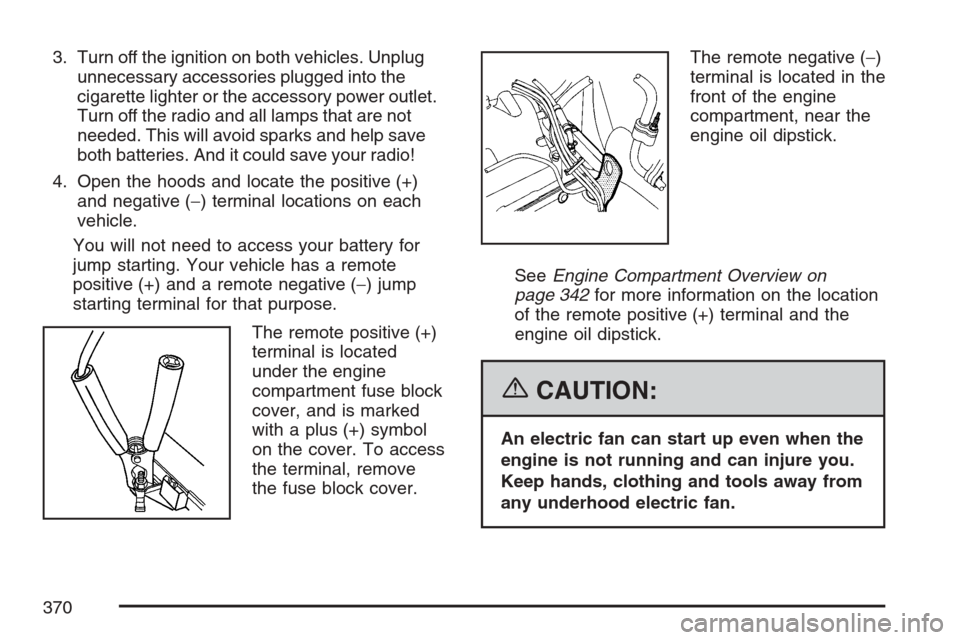Page 343 of 492
A. Engine Air Cleaner/Filter. SeeEngine Air
Cleaner/Filter on page 349.
B. Engine Oil Fill Cap. See “When to Add Engine
Oil” underEngine Oil on page 344.
C. Engine Oil Dipstick. See “Checking Engine Oil”
underEngine Oil on page 344.
D. Brake Fluid Reservoir. SeeBrakes on
page 365.E. Engine Compartment Fuse Block. SeeFuses
and Circuit Breakers on page 429.
F. Remote Positive (+) Terminal. SeeJump
Starting on page 368.
G. Engine Coolant Surge Tank. SeeEngine
Coolant on page 352.
H. Windshield Washer Fluid Reservoir. See
Windshield Washer Fluid on page 364.
343
Page 344 of 492
Engine Oil
Checking Engine Oil
It is a good idea to check the engine oil every time
you get fuel. In order to get an accurate reading,
the oil must be warm and the vehicle must be
on level ground.
The engine oil dipstick handle is a yellow loop.
SeeEngine Compartment Overview on page 342
for the location of the engine oil dipstick.
1. Turn off the engine and give the oil several
minutes to drain back into the oil pan. If you
do not do this, the oil dipstick might not
show the actual level.
2. Pull out the dipstick and clean it with a paper
towel or cloth, then push it back in all the
way. Remove it again, keeping the tip down,
and check the level.
When to Add Engine Oil
If the oil is below the cross-hatched area at the
tip of the dipstick, you will need to add at least
one quart/liter of oil. But you must use the
right kind. This section explains what kind of oil
to use. For engine oil crankcase capacity,
seeCapacities and Speci�cations on page 434.
344
Page 345 of 492
Notice:Do not add too much oil. If the engine
has so much oil that the oil level gets above the
cross-hatched area that shows the proper
operating range, the engine could be damaged.
SeeEngine
Compartment Overview
on page 342for the
location of the engine oil
�ll cap.Be sure to add enough oil to put the level
somewhere in the proper operating range in the
cross-hatched area. Push the dipstick all the
way back in when you are through.
SAE 5W-30 may not
appear on all caps.
345
Page 370 of 492

3. Turn off the ignition on both vehicles. Unplug
unnecessary accessories plugged into the
cigarette lighter or the accessory power outlet.
Turn off the radio and all lamps that are not
needed. This will avoid sparks and help save
both batteries. And it could save your radio!
4. Open the hoods and locate the positive (+)
and negative (−) terminal locations on each
vehicle.
You will not need to access your battery for
jump starting. Your vehicle has a remote
positive (+) and a remote negative (−) jump
starting terminal for that purpose.
The remote positive (+)
terminal is located
under the engine
compartment fuse block
cover, and is marked
with a plus (+) symbol
on the cover. To access
the terminal, remove
the fuse block cover.The remote negative (−)
terminal is located in the
front of the engine
compartment, near the
engine oil dipstick.
SeeEngine Compartment Overview on
page 342for more information on the location
of the remote positive (+) terminal and the
engine oil dipstick.
{CAUTION:
An electric fan can start up even when the
engine is not running and can injure you.
Keep hands, clothing and tools away from
any underhood electric fan.
370